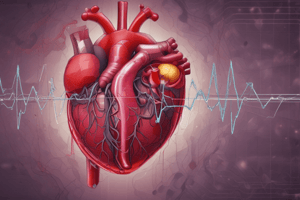Podcast
Questions and Answers
What is the primary distinction between paroxysmal and persistent AF?
What is the primary distinction between paroxysmal and persistent AF?
- The patient's age at diagnosis.
- The presence of structural heart disease.
- The presence of comorbidities.
- The duration of the AF episode. (correct)
What is the goal of rate control in atrial flutter treatment?
What is the goal of rate control in atrial flutter treatment?
- To reduce symptoms until sinus rhythm is restored. (correct)
- To restore sinus rhythm immediately.
- To eliminate the need for cardioversion.
- To prevent future episodes of atrial flutter.
Which of the following is NOT a treatment option for paroxysmal supraventricular tachycardia?
Which of the following is NOT a treatment option for paroxysmal supraventricular tachycardia?
- Direct current cardioversion
- IV Adenosine
- Warfarin therapy (correct)
- Catheter ablation
What is the primary indication for implantable cardioverter defibrillator therapy?
What is the primary indication for implantable cardioverter defibrillator therapy?
What is the difference between lone AF and other types of AF?
What is the difference between lone AF and other types of AF?
What is the first step in managing ventricular tachycardia?
What is the first step in managing ventricular tachycardia?
Flashcards are hidden until you start studying





